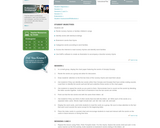
Students will be able to identify and act out common synonyms that convey shades of meaning.
- Subject:
- English Language Arts
- Material Type:
- Lesson Plan
- Provider:
- Education.com
- Author:
- Jennifer Morton
- Date Added:
- 02/26/2019

Students will be able to identify and act out common synonyms that convey shades of meaning.

In this lesson, student will listen to the book, "A New Coat for Anna". Students will learn about resources, scarcity, costs, trade/bartering, and decision making through a young girl, Anna, whose mother wanted to buy her a coat but did not have the money. Students will explain how families have needs and wants and various ways in which people earn and use materials, such as money, for goods and services. Students will see how supply and demand effects the choices families and communities make.

In this lesson, inspired by the book 'It Begins with an A', this minilesson invites kindergartners to combine their experiences with familiar objects and descriptive writing by making a class book. First, during a reading of It Begins with an A, students discuss descriptive works, number words, size words, and other words that describe objects in the book. Next, students practice by giving three clues that describe familiar objects named by the teacher. Students are encouraged to develop more specific and descriptive clues. Then, each student thinks of an object and draws it on the back of a sheet of paper. On the front of the paper, they write three clues that describe the object. Finally, the completed pages are combined to create a book that can be shared with family members and peers before adding it to their classroom library.

In this lesson, students will read the folk tale Jack and the Beanstalk and discuss the word giant and its beginning sound. Students then create their own lists of words that begin with the same sound. Then, students are introduced to words with the soft g sound and create a new list of words with this beginning sound. As a culminating activity, students work individually or in groups to categorize animal names into groups according to their beginning g sound.

Students will listen to a reading of Cloudy With A Chance Of Meatballs by Judi Barrett. This book is accessible via NC Kids Digital Library. After the read aloud, students will have the opportunity to engage in The Engineering Design Process to design a prototype/model of a hat or clothing to show how people might adapt to the unusual weather conditions as depicted in the story. Students will present their design/prototypes and explain how the designs help people adapt to weather conditions, per the NC Kindergarten Social Studies Standards.

In this lesson, students will read the book The Bears' Picnic by Stan and Jan Berenstain. As the book is read, a list should be compiled of the things the bears took on the picnic. The items on the list can then be grouped according to physical characteristics.

Students will work collaboratively in small groups of 3-4 students for this engineering design unit that integrates literacy to explore properties of objects by selecting the best materials to make their boats and investigate floating and sinking.

In this lesson, letter-sound correspondences are taught within a meaningful context in an explicit, systematic, and extensive manner. This lesson uses onset-rime analogy to present word families and spelling patterns. An onset is the consonant letter before the vowel in a given word or syllable, and a rime is the vowel and consonants that follow the vowel in a given word or syllable. Thus, in the word bill, the onset is the letter b and the rime is the letters ill. Furthermore, this lesson supports cooperative and integrative learning where students and teacher learn together and carry out tasks collaboratively.

In this lesson, students learn to identify written words with similar endings by singing and reciting nursery rhymes. Students begin by reciting Humpty Dumpty, identifying two words with similar ending sounds, and creating their own lists of words with the same ending sound. Students repeat this procedure with words from Peter, Peter, Pumpkin Eater and Jack and Jill. Finally, students access a website to identify the word families featured in other nursery rhymes and then create an illustration and text based on their favorite nursery rhyme.

In this lesson, students are first introduced to a variety of books using rebus writing. They then brainstorm lists of rhyming words that they could use in their own rebus poems. Finally, students create their own rebus poems and share them with an audience.